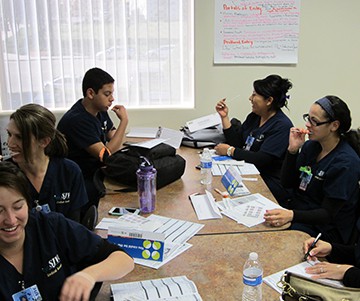Business, Medical and Technical program students hear request for bone marrow donations

Every four minutes, someone in the U.S. is diagnosed with a form of blood cancer, about 12,000 Americans each year. SJVC’s Temecula campus wants to be part of helping those who might benefit from a bone marrow transplant.
Dolores Ortiz, Community Engagement Representative for the Icla da Silva Foundation, a recruitment center for Be The Match Registry, made a presentation to Temecula students during three sessions held on campus last month.
“She spoke to students about bone marrow donations and what it could mean to a person with a life-threatening blood disease,” says Shannon Koh, Academic Dean. “Students got a chance to hear all about the registry process, listen to success stories, as well as what happens when a patient isn’t able to find a donor in time. It was a chance to give our students a powerful opportunity to be involved.”
This was the third time a Be the Match representative came to the college and invited students to register as bone marrow donors for their national donor program. Education about the registration and the extraction process was as essential as the compelling statistics regarding those waiting for donations and the number of those helped by the generous spirit of communities everywhere.
Ninety-eight of the roughly 150 students who attended the Be the Match event completed an application and cheek swab to become a bone marrow registrant. Student volunteers filled out a consent form and provided a cheek swab in the hope of being a match for someone in the registry who is fighting cancer. It takes about 6-8 weeks to process the swab before the donor is officially added to the national registry.
“I didn’t hesitate to register because it could really benefit others,” says Bryce Harper, HVAC student. “A small inconvenience to me could be life-changing for someone else.”
If a match is made, the donor may decline participation or continue with the process by one of two methods of extraction. The first method is similar to donating blood via an IV in the donor’s arm. Blood stem cells are removed from the blood before being returned through a second IV. This is the method by which 75 percent of donations are made, as determined by the patient’s doctor.
The second method is an outpatient surgical procedure performed under anesthesia. A small amount of liquid marrow is extracted from the donor’s pelvic bone, with minimal side-effects.
All travel expenses, including meals, car rental and child care, are covered by the national Be the Match Registry.
One of the most important aspects of registration is the appeal to a diverse ethnicity of donors. Potential matches are much more likely among shared racial backgrounds. Still, matches are rare with only one match for every 543 donors. Matches are much higher among family members, with a 30 percent potential.
“Currently 12,000 people per year are in need of transplants,” says Dolores Ortiz. “Be the Match is able to facilitate transplants for about half of those people, with a patient’s likelihood of finding a matching donor estimated to range from 66-97 percent, depending on race and ethnicity.”
The thought of making such a personal contribution can be a little intimidating.
“I was really scared to donate, but it was the right thing to do,” says Aaliyah Lampkin, Medical Assisting student. “When I saw the pictures of the babies and small children waiting for donors, I knew I needed to register.”
“We have facilitated more than 68,000 marrow and cord blood transplants – which is an average of more than 520 transplants a month,” says Ms. Ortiz. “Each day we give 17 patients hope for a future.”
Many Temecula campus students from the Respiratory Therapy, Pharmacy Technology, Dental Assisting, Medical Assisting, Medical Office, and Heating, Ventilation and Air Conditioning programs can be counted on to make it as personal as it gets to help save a life.
More stories about
Request Information
All fields using an asterik (*) are required.